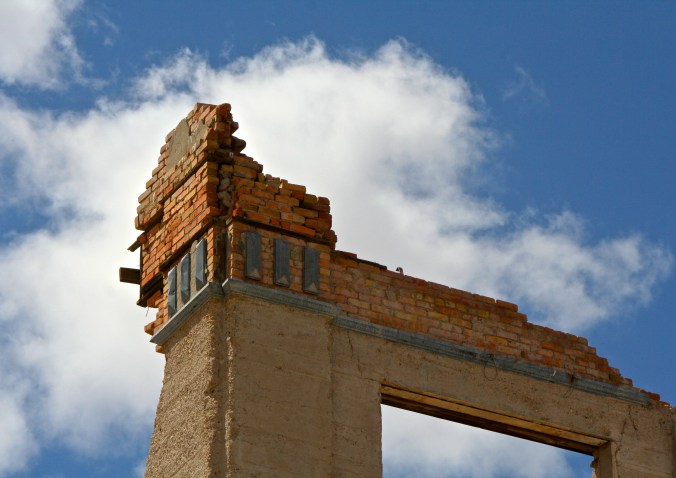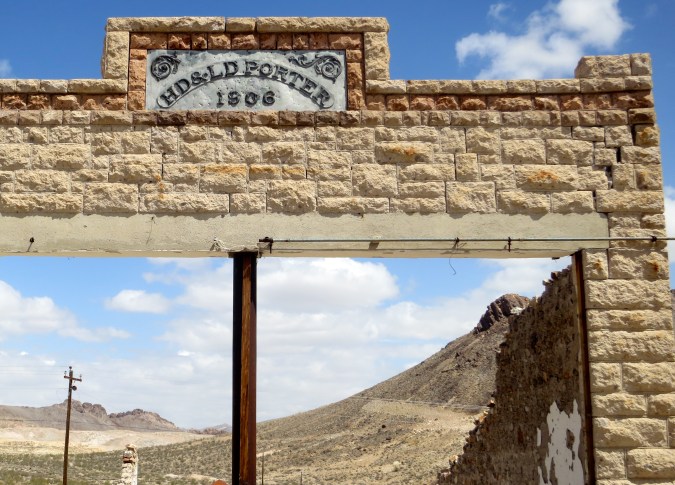
What better way to introduce a ghost town than to show where the ghosts live? This is one of the better kept grave sites in the Rhyolite cemetery. (Photo by Peggy Mekemson.)
What’s a desert without a ghost town or two?
Boom and bust are the go-to words when it comes to creating ghost towns in the desert. Gold, or some other valuable mineral is found. Miners, developers, speculators and others burning with get-rich-quick-itis rush in where angels fear to tread (wisely so). Eventually the vein runs out. Unless the town has other ways of providing a livelihood, people leave. The ghosts are left behind. That’s the story of Rhyolite.
Boom! At the beginning of January in 1905, Rhyolite was a non-town of two people. They struck it rich. Two weeks later the population had grown to 1200 people. By 1907 somewhere between 4,000 and 8,000 people called the place home. Apparently no one was interested in doing an accurate census count. But the small city had banks, a school, its own railroad, a hospital, an opera house, some 50 saloons and a generous smattering of ladies of the evening with hearts of gold, or at least pockets filled with gold coins. There was electricity, running water, and telephones.
Charles Schwab, the steel magnate, (as opposed to Charles Schwab of brokerage house fame) was the money behind the development of Rhyolite. Thomas Edison, who was responsible for inventing the electric lights that lit up the town, once called Schwab a master hustler. It fit, but Schwab’s hustling in Rhyolite failed to pan out (to use an old gold mining term).
Bust! In 1907, a British mining engineer discovered that the ‘fabulously high-grade ore’ mine Schwab had bought was actually filled with low-grade ore. By 1910 the banks were closed. The last train left town in 1916. A motor tour organized by the LA Times in 1922 found only one person remaining in the town, a 94-year-old man who died two years later. Rhyolite began its career as a ghost town.
For enquiring minds that want to know, Rhyolite is located approximately 120 miles north of Las Vegas and sits on the eastern edge of Death Valley, just outside the small Nevada town of Beatty. It is named after an igneous rock common throughout the area.

I was torn over which interior photograph I would use, but opted for the steering wheel and dashboard. It, and the faded surrounding mountains struck me as ghostly. The odometer had stopped at 45,438 miles. Or make that 45,438.5. It was rolling over to 45,439 when its roving days ended.

Almost everything of value was ripped out of the Cook Bank and Rhyolite in general. Many of the buildings in nearby Beatty, owe their existence to this pilferage. It led me to wonder why the fine bricks on top of the Cook Bank were still there. Were they a little difficult to reach, a little perilous to remove? (Photo by Peggy Mekemson.)

I asked Peggy, a retired elementary school principal, to pose for me in front of Rhyolite’s school. Her hair, which totally has a mind of its own, had been teased by the desert wind.

They say it is better to be on the inside looking out than the outside looking in. I don’t think it matters in Rhyolite. But I did like the composition that pulls you out toward the mountains.

Speaking of classy, Rhyolite’s railway station was, and still is an attractive building. Over the years it morphed into a hotel, casino, souvenir shop, all connected to Rhyolite’s ghost town status. (Photo by Peggy Mekemson.)

Most of the rails leading up to the station were pulled out and used during World War I, but I did find this old one in a junk pile behind the station.

One of the more intriguing buildings in Rhyolite, from my perspective, is this old caboose that was once used on the Las Vegas to Salt Lake line. It was reborn as a service station in Rhyolite to serve the visitors that came to visit the ghost town and probably the casino.

This house made of 30,00 glass bottles (mainly alcohol related– not surprising considering a couple of thousand thirsty miners), may be Rhyolite’s most famous building. 76-year-old Tom Kelly built it in 1905-06 and then auctioned it off at $5.00 a ticket.

A close up of the bottles. The marks on the bottom indicate the company that made the bottles. AB stands for American Bottling Company, for example. (Photo by Peggy Mekemson.)

A few bottles are more prominently displayed, such as this Dr. J. Hostetter Bitters bottle. While it was sold to cure what ailed your tummy, it contained up to 47 % alcohol. Earlier, Hostetter had sold the bitters to Union soldiers during the Civil War to fight off diseases they might catch while chasing Confederates through southern swamps.
NEXT BLOG: Traveling a couple of hundred yards west of Rhyolite, we visit the Goldwell Open Air Museum





